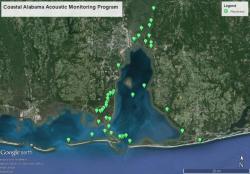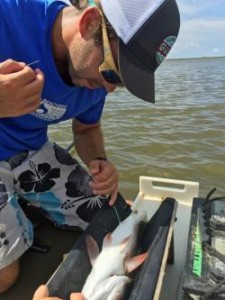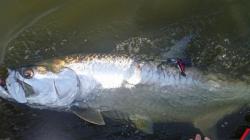“Bugging” the Fish on Mobile Bay and Mississippi Sound
Today’s feature comes to us from David Rainer of the Alabama Department of Conservation and Natural Resources
from The Fishing Wire
The microphones, known as hydrophones, are strategically positioned around the Bay and Sound to listen for the fish themselves – a select group of fish.
In a study sanctioned by the Alabama Marine Resources Division (MRD), several inshore fish are being fitted with sonic devices that will be picked up by the hydrophones to get a better idea of where and how much they travel during the year.
Chris Blankenship, MRD Director, said the project is in collaboration with the Mississippi Department of Marine Resources, which has hydrophone stations on the west side of Mississippi Sound.
“This should give us a better picture of the movement of those inshore fish,” Blankenship said. “It started as a tarpon project because that’s Alabama’s state saltwater fish, but we had very little information about the movement of tarpon in our area. Once the hydrophones were out, we had the opportunity to include other species, so we added red drum (redfish) and spotted seatrout (speckled trout) to learn about those fish movements at the same time.
“The interesting thing is that for any fish with an acoustic tag that we pick up, we share that information. Like sturgeon. The U.S. Fish and Wildlife Service has tagged some sturgeon in some of the creeks and rivers in Florida. Occasionally, we’ll pick up some of those fish in our array, and we’ll share that with the people who are gathering data on those fish.”
Dr. Sean Powers and the University of South Alabama Marine Sciences Department are conducting the study, which has been dubbed CAAMP, the Coastal Alabama Acoustic Monitoring Program. There is an array of 40 listening stations with hydrophones strategically placed around Mobile Bay and Mississippi Sound.
“The hydrophones were placed around the bay to cover the entry and exit points of fish, and in this instance, we’re talking about a red drum or speckled trout,” Powers said. “We have all the rivers covered in the (Mobile/Tensaw) Delta. We have a string of them along the Causeway, at Fowl River and Dog River. We also have them in Mississippi Sound.
“Our colleagues in Mississippi and Florida are using same type hydrophones, and we share data. So although we only cover Alabama with our 40 hydrophones, we have partnerships that cover the Gulf from Louisiana to Tampa.”
The hydrophones are designed to pick up acoustic signals with unique codes that identify individual fish. The acoustic tag sends a series of sound pulses in a few seconds. The hydrophone interprets that signal and identifies the fish. If it was a fish from Alabama, the identification of the fish gives researchers data on where the fish was tagged and where it was located when the signal was picked up at different times. If the hydrophone identifies an unknown code, the other states involved in the program are notified.
Each fish in the study is caught by researchers or other anglers and the small tag is attached.“We do a little surgery on the fish,” Powers said. “We insert a little tag. It’s about half the size of a AAA battery. Sound travels really well in saltwater, so we don’t need that big of an amplifier. A little tag can do a whole lot. It sends that pulse out every minute. The tags will last a year. When it swims within 500 meters of a hydrophone, the signal is picked up and will tell us the fish was alive in that location. With our array of hydrophones and collaboration with the other states, we get good information on movement of fish, the seasonal movement of fish.”
The Mobile/Tensaw Delta and its role in the movement of inshore species is of particular interest to the researchers. Typically, the inshore species follow the migration of shrimp and other food sources into the rivers and creeks in the fall, depending somewhat on water salinity and flow.
“One thing we’re really interested in is how the saltwater fish use that Delta – when, and potentially why, they use that Delta area,” Powers said. “Although we have hydrophones all around the Bay, it’s a little more weighted toward the Delta, Fowl River and Dog River.”
The acoustic study is being done in stages, according to species. The first year is red drum. Powers said about 100 redfish have already been tagged.
“That was the fun part,” he said. “We went out and tagged them all around the Bay, some in the Delta and some off Fairhope, some off Bon Secour and some off Dauphin Island.“What we will get is very important information on movement, and we’ll get important information on survivorship. We know how many fished we tagged. We have rewards so fishermen can call the information in to us if they catch one. That way we’ll be able to tell how many survived.”
That rate of survival, or escapement, plays a crucial role in the management of red drum, Powers said. Current management models are based on 30-percent escapement.
“What that means is 30 percent survive to go offshore and spawn,” he said. “The fish we tagged are within the state slot limit of 16 to 26 inches. What we would like to see is verification that at least 30 percent of those survive.”
The red drum study will be expanded next year with different parameters. Half the fish tagged will be wild fish, and half will be fished raised at the Marine Resources Division’s Claude Peteet Mariculture Center in Gulf Shores.
“We’re really interested to see if there is a difference in movement in wild red drum versus hatchery-raised red drum,” Blankenship said.
Speckled trout will be added to the study in year three; however, several speckled trout that were part of the live weigh-in for the Alabama Deep Sea Fishing Rodeo were tagged and released as well. Powers said the species for years four and five are undecided but could include flounder and/or sheepshead.
Before CAAMP came into existence, Powers said a tarpon study had been underway for a couple of years.
“We worked with fishermen on the tarpon, because you’ve got to be pretty good to catch a tarpon,” he said. “We tagged about a dozen tarpon, and we’ve also got satellite tags on a couple of fish that will pop off and float. We also have one receiver off Gulf State Park Pier, so we expect to hear a few tarpon ticking off Gulf State Pier.”
Powers said the information from the hydrophones is downloaded about every six months.
“Sometime next year we should have some good information,” he said. “We know that we’ve already heard from some of the tarpon and some of the red drum. The good thing about the red drum tags is some of the freshwater folks have receivers out to listen for sturgeon, and they’ve already heard some of our redfish up in the rivers.”
PHOTOS: (Crystal Hightower, tarpon by Andrea Kroetz) As part of the CAAMP array, hydrophones are stationed in Alabama coastal waters to pick up the signals from the tagged fish to study seasonal movements and escapement rates. A small acoustic device is inserted by Reid Nelson into the body cavity of the red drum in the study. Larger tags are attached near the dorsal fin on tarpon.


